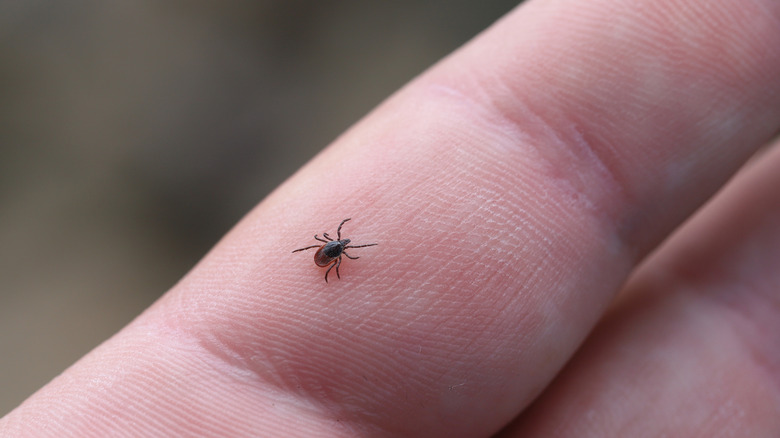Ward Off Unwanted Ticks With An Easy Essential Oil Hack
We may receive a commission on purchases made from links.
Tick season is once again upon us, and if you're not prepared, they could be hitching a ride on you or your pets. No one wants to find these bloodsuckers feeding on their leg. Even worse than the panic they cause, ticks can carry diseases that you don't want to risk catching. You can protect your pets with flea and tick medications (consult your vet for the best fit), but how do you keep them off you? If you're looking to avoid a chemical solution, you've probably heard of using salt to get rid of ticks, but that method isn't entirely foolproof. An option you should consider is using essential oils from plants like clove buds, thyme, citronella, and oregano.
Clove bud oil is derived from the buds of clove trees (Syzygium aromaticum) and has been cited in multiple studies as one of the most efficient essential oil repellents. Clove oil is considered to be generally regarded as safe by the FDA for consumption and has a Minimum Risk Pesticide label from the EPA. Clove bud oil, when diluted to 3%, has an 83% efficiency in repelling ornate cattle ticks. It is proven to be an active deterrent for up to eight hours against castor bean ticks, too. Results may still vary across different tick species.
One benefit of using essential oils is the ability to make your own repellents and control ingredients. If you want to create your own clove bud oil repellent, you can mix one ounce of water with 10 to 15 drops of clove bud oil. Consider adding a carrier oil, like solubol, to prevent irritation.
Other effective essential oils
If you plan to stay safe from ticks with simple ingredients, clove is not the only essential oil that may help your cause. Consider trying spearmint or oregano oils on your clothes. When diluted to just 5%, both have a comparable repellence to DEET, a commonly used chemical tick repellent. These results are expected to last for 24 hours. Spearmint could even be able to prevent some ticks from climbing. You can make an oregano repellent by mixing 5 to 6 drops of the oil per ounce of carrier oil.
Thyme varieties may also repel ticks. When tested, creeping thyme and red thyme essential oils repelled up to 82% and 68% of ornate cattle ticks, respectively. Like spearmint oil, thyme oils were also likely to cause ticks to detach from clothing. Even more potent, a mixture of creeping thyme and citronella can repel up to 91% of ornate cattle ticks. This repellent requires 5 drops of thyme and 10 to 15 drops of citronella in some water, with some drops of solubol to help them mix.
Another commonly mentioned essential oil in this discourse is lemon grass. Lemon grass can repel fleas and ticks with the benefit of being pet safe. Citronella is actually derived from lemongrass oil. Unfortunately, the duration of effectiveness is shorter, lasting only between half an hour to two hours. If you'd rather order a natural repellent, this popular Nantucket Spider Extra Strength Tick Repellent Spray is available on Amazon.
Avoiding and removing ticks
If you're looking to avoid ticks altogether, try to stay out of the woods and any long vegetation. When you're on a hiking trip, stay on the path or wear long clothes that keep you covered. Even consider tucking your pants into your socks. Ultimately, make sure you check yourself after being outdoors in any place that ticks might frequent.
If you find a tick, it is not the end of the world, but the sooner you find it, the better. Lyme disease, for example, takes at least 24 hours to transmit from the tick. If the tick has not bitten you yet, use tweezers or gloves to remove it. If it is attached, use tweezers to grab the tick and extract it by the head, without twisting or yanking. After, apply an antibacterial ointment and keep an eye on the site. Contact your doctor if you believe the tick was attached for several hours.


